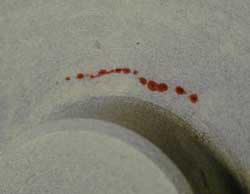NDE - ENGINEERING 2 PRODUCTION, INC.
Nondestructive Examination (NDE) provides an accurate evaluation of the condition of equipment and materials.
Whether your equipment is operating or down for maintenance, NDE can pinpoint defects and flaws within your equipment and save you costly downtime later.
E2P is staffed with highly qualified and experienced NDE Technicians. NDE is performed in accordance with ASNT-TC- IA.

|
LIQUID DYE PENETRANT (LP)
LP is used to detect discontinuities which are open to the surface of the material being examined.
This method may be used for ferrous and nonferrous materials.
LP examination is used for the detection of surface discontinuities such as cracks, seams, laps, laminations or porosity.
LP inspection is a method that is used to reveal surface breaking flaws by bleedout of a colored or fluorescent dye from the flaw.
The technique is based on the ability of a liquid to be drawn into a "clean" surface breaking flaw by capillary action.
After a period of time called the "dwell," excess surface penetrant is removed and a developer applied.
This acts as a blotter. It draws the penetrant from the flaw to reveal its presence.
Colored (contrast) penetrants require good white light while fluorescent penetrants need to be used in darkened conditions with an ultraviolet "black light".
|
|

|
MAG PARTICLE INSPECTION (MP)
MP is used for detecting discontinuities in ferromagnetic parts.
The part is magnetized by using an electrical current that induces a magnetic field in the part.
A discontinuity, which crosses the magnetic field, creates north and south poles on either side of the defect area.
When magnetic particles are applied to the part, the poles attract the particles and an indication of the discontinuity is formed.
MP is often used to look for cracking at welded joints and in areas identified as being susceptible to environmental cracking (e.g. stress corrosion cracking or hydrogen induced cracking), fatigue cracking or creep cracking.
Wet fluorescent MP finds widespread use in looking for environmental damage on the inside of vessels.
Mag Particle Inspection is particularly sensitive to surface-breaking or near-surface cracks, even if the crack opening is very narrow.
However, if the crack runs parallel to the magnetic field, there is little disturbance to the magnetic field and it is
unlikely that the crack will be detected. For this reason it is recommended that the inspection surface is magnetized in two directions at 90° to each other.
Alternatively, techniques using swinging or rotating magnetic fields can be used to ensure that all orientations of crack are detectable.
|
|

|
ULTRASONIC EXAMINATION (UT)
UT is commonly used to examine for surface and subsurface discontinuities,
the depth and exact size can be determined by use of the proper technique.
Ultrasonic pulses are directed into the test object which produces echoes and reflections which then indicates the presence,
absence and location of flaws, interface and/or discontinuities. UT for thickness determines thickness or reveals corrosion
discontinuities near the surface or deep within components or structures.
It offers the advantage of examining components without removal or disassembly.
Typical applications are examining a tank or pressure vessel to determine its mechanical integrity or examining a rotating equipment
shaft for possible fatigue cracks in areas of high stress concentrations.
|
|


